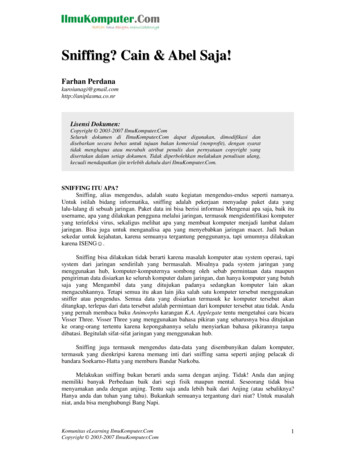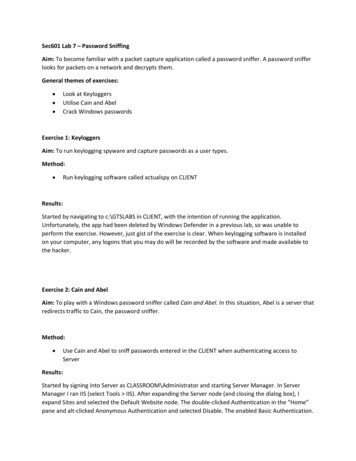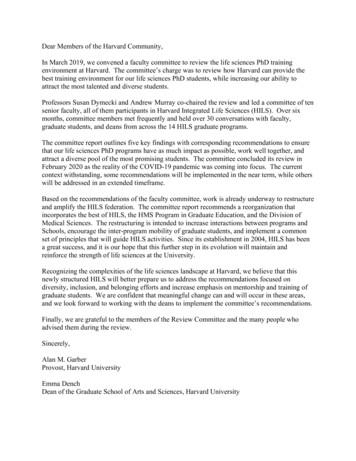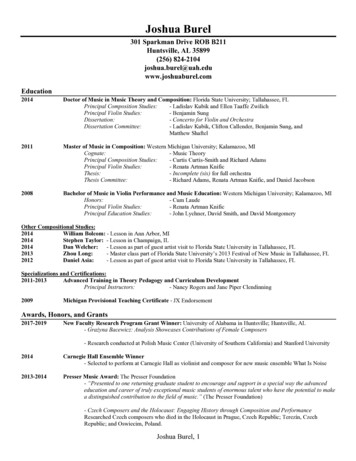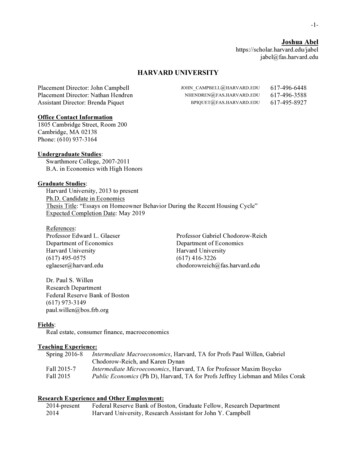
Transcription
-1-Joshua vard.eduHARVARD UNIVERSITYPlacement Director: John CampbellPlacement Director: Nathan HendrenAssistant Director: Brenda PiquetJOHN 927Office Contact Information1805 Cambridge Street, Room 200Cambridge, MA 02138Phone: (610) 937-3164Undergraduate Studies:Swarthmore College, 2007-2011B.A. in Economics with High HonorsGraduate Studies:Harvard University, 2013 to presentPh.D. Candidate in EconomicsThesis Title: “Essays on Homeowner Behavior During the Recent Housing Cycle”Expected Completion Date: May 2019References:Professor Edward L. GlaeserDepartment of EconomicsHarvard University(617) 495-0575eglaeser@harvard.eduProfessor Gabriel Chodorow-ReichDepartment of EconomicsHarvard University(617) 416-3226chodorowreich@fas.harvard.eduDr. Paul S. WillenResearch DepartmentFederal Reserve Bank of Boston(617) 973-3149paul.willen@bos.frb.orgFields:Real estate, consumer finance, macroeconomicsTeaching Experience:Spring 2016-8 Intermediate Macroeconomics, Harvard, TA for Profs Paul Willen, GabrielChodorow-Reich, and Karen DynanFall 2015-7Intermediate Microeconomics, Harvard, TA for Professor Maxim BoyckoFall 2015Public Economics (Ph D), Harvard, TA for Profs Jeffrey Liebman and Miles CorakResearch Experience and Other Employment:2014-presentFederal Reserve Bank of Boston, Graduate Fellow, Research Department2014Harvard University, Research Assistant for John Y. Campbell
-22011-13Federal Reserve Bank of New York, Research Assistant, Research and StatisticsDepartmentHonors, Scholarships, and Fellowships:2015, 2017-18 Harvard Certificate of Distinction in Teaching (awarded 3 times)2017Harvard Joint Center for Housing Studies Meyer Dissertation Fellowship2011Swarthmore College Adams Prize in Economics2011The Phi Beta Kappa SocietyPublications:“The Measurement and Behavior of Uncertainty: Evidence from the ECB Survey of ProfessionalForecasters,” with Robert Rich and Joseph Song and Joseph Tracy. 2016. Journal of AppliedEconometrics, 31.We examine matched point and density forecasts of output growth, inflation and unemployment from theECB Survey of Professional Forecasters. We construct measures of uncertainty from individual histograms,and find that the measures display countercyclical behavior and have increased across all forecast horizonssince 2007. We also derive measures of forecast dispersion and forecast accuracy, and find that they are notreliable proxies for uncertainty. There is, however, evidence of a meaningful co-movement betweenuncertainty and aggregate point predictions for output growth and unemployment. These results are robustto changes in the composition of the survey respondents over time.Research Papers:“How Do Mortgage Refinances Affect Debt, Default, and Spending? Evidence from HARP”(Job Market Paper; joint with Andreas Fuster; revise and resubmit at American Economic Journal:Macroeconomics)We use quasi-random access to the Home Affordable Refinance Program (HARP) to identify the causaleffect of refinancing a mortgage on borrower balance sheet outcomes. We find that on average, refinancinginto a lower-rate mortgage enabled borrowers to cut their default rates on mortgages by around 40% andtheir rates of serious delinquency on non-mortgage debts by about 25%. Refinancing also causes borrowersto expand their use of debt instruments, such as auto loans, home equity lines of credit (HELOCs), andother consumer debts that are proxies for spending. All told, refinancing led to a net increase in debt equalto about 20% of the savings on mortgage payments. This number combines increases (new debts) of about60% of the mortgage savings and decreases (pay-downs) of about 40% of those savings. Borrowers withlow FICO scores or low levels of unused revolving credit grow their auto and HELOC debt more stronglyafter a refinance, but also reduce their bank card balances by more. Finally, we show that take-up of therefinancing opportunity was strongest among borrowers that were in a relatively better financial position tobegin with.“The Home Sale Volatility Puzzle: Equity Constraints, Loss Aversion, and Irreversible Construction”The recent housing cycle in the United States saw large swings not only in home prices but in home sales aswell. This paper begins by using a comprehensive dataset on US home sales to investigate two popularexplanations for the cyclicality of selling activity: “house lock," which conjectures that falling prices causedown-payment constraints to bind and prevent current homeowners from selling their homes; and nominalloss aversion, which proposes that cognitive frictions prevent homeowners from selling when doing sowould not garner a price as high as the one they originally paid for the house. I find that while there isevidence that both of these mechanisms are active at the household level, they explain a fairly small portionof the decline in sales from boom to bust: likely no more than 10%. I then propose a novel mechanism,which is that construction of New homes, which tend to be of higher quality, unlocks sales of Existinghomes during booms, as there is aggregate movement up the housing ladder. In the bust, this movementfreezes, and it does not reverse, as the irreversibility of construction prevents the market from tearing downnice homes and facilitating an aggregate down-size. As a result, sales are high in the boom and low in thebust. I show that the model's predictions are consistent with recent dynamics of aggregate prices andvolume, as well as cross-MSA variation in sales. Overall, without any amplification, the model is able toexplain up to 30% of the aggregate movements in sales over the previous cycle. I conclude by discussingfactors that could increase or decrease this magnitude.
-1-CHRISTOPHER n@hbs.eduHARVARD UNIVERSITYPlacement Director: John CampbellPlacement Director: Nathan HendrenAssistant Director: Brenda PiquetJOHN T@FAS.HARVARD.EDUOffice Contact InformationBaker Library 244BHarvard Business SchoolBoston, MA 02163617-496-6448617-496-3588617-495-8927Home Contact Information5 Cowperthwaite St #425Cambridge, MA 02138Phone: (415) 300-6085Personal Information:Citizenship: United StatesDate of birth: September 27, 1990Undergraduate Studies:B.A. Mathematics and Economics, University of California at Berkeley, 2012Graduate Studies:Harvard University, 2014 to PresentPh.D. Candidate in Business EconomicsThesis Title: “Essays in Financial Economics”Expected Completion Date: May 2019References:Professor John CampbellLittauer Center 213john campbell@harvard.eduProfessor Matteo MaggioriLittauer Center 212maggiori@fas.harvard.eduProfessor Malcolm BakerBaker Library 261mbaker@hbs.eduResearch Fields:Primary field: Asset pricingSecondary fields: Corporate finance, behavioral finance, macroeconomicsTeaching Experience:Spring, 2017Investment Strategies, Harvard Business School, teaching fellow for ProfessorsMalcolm Baker and Samuel HansonResearch Experience and Other Employment:2012-2014Federal Reserve Board of Governors, Research AssistantDivision of Banking Supervision and Regulation2010-2011Ulrike Malmendier, Research Assistant
-2-Professional ActivitiesServiceOrganizer of Harvard PhD finance lunch from 2016-2018ConferencesYale Doctoral Fall Finance Conference 2018, Trans-Atlantic Doctoral Conference2018WorkshopsMacro Financial Modeling Summer Session for Young Scholars 2018 and 2016,MIT Capital Markets Workshop 2017, Yale Summer School in Behavioral Finance2017, Princeton Initiative in Macro, Money, and Finance 2016Research Papers:“Consumption-Based Asset Pricing Without Optimal Consumption Choice” [Job Market Paper]The predictions of consumption-based asset pricing models rely heavily on the assumption thatconsumers optimize perfectly. Slight deviations from optimal consumption, such as consumerswho react to news with a delay, can completely break these models' predictions. To address thisproblem, I separate consumption and portfolio choice in order to identify which predictions holdwhen consumption is non-optimal. I build a model in which a portfolio manager selects portfolioweights on behalf of a consumer. The consumer has a potentially non-optimal consumption policywhich could reflect a range of realistic consumption frictions. In the case of power utility, riskpremia depend on exposure to long-horizon consumption and expected return shocks, not singleperiod consumption as in the standard model. My results apply to a wide range of environmentsand generalize beyond power utility. In the general case, long-horizon risks matter whenconsumers do not react to shocks optimally. I provide empirical evidence that expected returnshocks are negatively priced in the cross section of stock returns, as the model predicts, and canaccount for 1.3 percentage points of the equity premium.“The Shadow Price of Intermediary Constraints” (with Weiling Liu)Limits to the risk-taking activities of financial intermediaries are important for understandingmarket stability as well as asset prices, yet they remain difficult to pin down. We propose a novelmeasure of intermediary risk constraints called the interdealer broker (IDB) ratio, which is thepercent of total trade volume conducted between dealers using an IDB. Theoretically, whenaggregate risk constraints tighten, dealers will use IDBs more in order to redistribute idiosyncraticrisk. Empirically, we test our measure in the U.S. Treasury market, where we find that the IDBratio has a 0.72 correlation with interest rate risk, as proxied by Value-at-Risk. Consistent with astory of risk premia, a one standard deviation increase in the IDB ratio forecasts a 1.8 percentagepoint higher annual excess return on a five-year bond. This return predictability holds acrossdifferent fixed income classes, over varying maturities, as well as out-of-sample.
JONATHAN P. BEAUCHAMP OCTOBER 2018JONATHAN P. hamp/homejonathan.beauchamp@utoronto.caContact Information:Department of EconomicsUniversity of TorontoMax Gluskin House, 150 St. George Street, 306Toronto, Ontario M5S 3G7, Canada 1 (416) 978-4978Citizenship: CanadianProfessional Experience:Assistant Professor, Department of Economics, U. of Toronto (Jul. 2016-now)Assistant Professor, Munk School of Global Affairs and Public Policy, U. of Toronto (CrossAppointed Affiliated Faculty; Jul. 2018-now)Associate Investigator, The Centre for Applied Genomics (Oct. 2018-now)Postdoctoral Fellow, Department of Economics, Harvard University (Jan. 2015-Jul. 2016)Economist, Monetary & Capital Markets Dept., International Monetary Fund (Dec. 2013-Dec. 2014)Associate, specialization in the Risk Practice, McKinsey & Company (Sept. 2011-Dec. 2013)Education:Harvard University, Ph.D., Economics, May 2011Queen’s University, M.A., Economics, Aug. 2006Queen’s University, B.Sc. (Honours), Mathematics, Minor in Economics, with Distinction, May 2005References:References:Professor David LaibsonDepartment of EconomicsHarvard Universitydlaibson@harvard.edu 1 (617) 496-3402Professor Daniel BenjaminCenter for Economics and Social ResearchUniversity of Southern Californiadjbenjam@usc.edu 1 (213) 821-2769Professor David CesariniDepartment of EconomicsNew York Universitydavid.cesarini@nyu.edu 1 (212) 998-3773Teaching and Research Fields:Primary fields: Applied MicroeconomicsSecondary fields: GenoeconomicsAdditional teaching fields: Econometrics, Behavioral Economics, Cultural Economics1
JONATHAN P. BEAUCHAMP OCTOBER 2018Journal Referee:The Quarterly Journal of Economics; The Journal of Political Economy; Journal of the EuropeanEconomic Association; American Economic Journal: Applied Economics; Review of Economics andStatistics; Experimental Economics; European Economic Review; Journal of DevelopmentEconomics; American Journal of Health Economics; Economics and Human Biology; Journal ofEconomic Psychology; Science; Proceedings of the National Academy of Sciences; NatureNeuroscience; Nature Communications; Economics and Human Biology; Journal of Neuroscience,Psychology, and Economics; Hereditas.Selected Presentations and Invited Talks (Including Upcoming Events):2019Allied Social Science Associations (ASSA) Annual Meeting, Atlanta2018Symposium at the Allen Institute on What Makes us Human and the Geneticsof Complex Traits, Seattle, WashingtonSeminar at George Mason UniversityIntegrating Genetics and the Social Sciences Conference, BoulderConference on Evolution and Financial Markets, Cambridge2017American Society of Human Genetics 2017 Annual Meeting, OrlandoConference on Polygenic Prediction and its Application in the Social Sciences,University of Southern California, Los AngelesSeminar at the University of British ColumbiaSeminar at Simon Fraser UniversityCIFAR-SIIWB Meeting, Toronto2016Seminar at the Center for Economic and Social Research, University ofSouthern CaliforniaHCEO’s Conference on Genetics and Social Science, Los AngelesIntegrating Genetics and the Social Sciences Conference, BoulderSeminar at Binghampton UniversitySeminar at the University of Toronto2015Invited talk at the McLaughlin Centre, University of TorontoSeminar at the University of Chicago Dept. of Economics, LifecycleWorking GroupBehavior Genetics Association Annual Meeting, San DiegoInvited talk at Midi Conférence de l’IGF, Montreal2010Seminar at Erasmus School of Economics, RotterdamIntegrating Genetics and the Social Sciences Conference, Boulder2009IZA/Volkswagen Foundation Workshop: Genes, Brains, and the LaborMarket, BonnSelected Honors, Scholarships, and Fellowships:2008-11Trudeau Scholarship2006-10SSHRC Canada Doctoral Fellowship2006-08Harvard Douglas Dillon Fellowship Fund2005-06SSHRC Canada Graduate Scholarship2001-05Canada Millennium National Excellence Scholarship2001-05Queen’s Chancellor’s (Senator Frank Carrel Honour) ScholarshipLanguages:English, French (native fluency); German (advanced); Spanish (beginner)2
JONATHAN P. BEAUCHAMP OCTOBER 2018Research Papers:Job Market Paper: With the Social Science Genetic Association Consortium (co-starred senior author).“Genome-wide association analyses of risk tolerance and risky behaviors in over one million individualsidentify hundreds of loci and shared genetic influences.” (Accepted by Nature Genetics.)Humans vary substantially in their willingness to take risks. In a combined sample of over one million individuals,we conducted genome-wide association studies (GWAS) of general risk tolerance, adventurousness, and riskybehaviors in the driving, drinking, smoking, and sexual domains. Across all GWAS we identified hundreds ofassociated loci, including 99 loci associated with general risk tolerance. We report evidence of substantial sharedgenetic influences across risk tolerance and the risky behaviors: 46 of the 99 general risk tolerance loci contain alead SNP for at least one of our other GWAS, and general risk tolerance is genetically correlated (!𝑟̂ ! 0.25 to0.50) with a range of risky behaviors. Bioinformatics analyses imply that genes near general-risk-toleranceassociated SNPs are highly expressed in brain tissues and point to a role for glutamatergic and GABAergicneurotransmission. We found no evidence of enrichment for genes previously hypothesized to relate to risktolerance.Jonathan Beauchamp, Christopher F. Chabris, Daniel J. Benjamin, and David I. Laibson. “Controlling forthe Compromise Effect Debiases Estimates of Risk Preference Parameters.” NBER Working Paper No. 21792.DOI: 10.3386/w21792. (Revise & Resubmit at Experimental Economics.)Jonathan Schulz, Duman Bahrami-Rad, Jonathan Beauchamp, and Joseph Henrich. “The Origins of WEIRDPsychology.” PsyArXiv. DOI: https://psyarxiv.com/d6qhu/. (Submitted and under review.)Jonathan Beauchamp, Aysu Okbay, Sven Oskarsson, and Kevin Thom. “Of Genes and Screens: EducationalReform, Ability, and Labor Market Screening.” Working Paper.Research in Progress:“Nature via Nurture: Evidence from Adoptees and Implications for Intergenerational Mobility” (with JamesLee and Matt McGue).“Kinship Systems and Economic Outcomes” (with Duman Bahrami-Rad, Joe Henrich, and Jonahan Schulz).Publications:With the Social Science Genetic Association Consortium. 2018. “Gene Discovery and Polygenic Predictionfrom a 1.1-Million-Person GWAS of Educational Attainment.” Nature Genetics, 50: 1112–1121.Jonathan Beauchamp, David Cesarini, and Magnus Johannesson. 2017. “The Psychometric and EmpiricalProperties of Measures of Risk Preferences.” Journal of Risk and Uncertainty, 54: 203-237.Jonathan Beauchamp. 2016. “Genetic Evidence for Natural Selection in Humans in the ContemporaryUnited States.” Proceedings of the National Academy of Sciences, 113: 7774-7779.With the Social Science Genetic Association Consortium (co-starred senior author). 2016. “GeneticVariants Associated with Subjective Well-Being, Depressive Symptoms, and Neuroticism Identifiedthrough Genome-Wide Analyses.” Nature genetics, 48: 624-633.With the Social Science Genetic Association Consortium (co-starred leading author). 2016. “Genome-WideAssociation Study Identifies 74 Loci Associated with Educational Attainment.” Nature, 533: 539-542.With the Social Science Genetic Association Consortium. 2013. “GWAS of 126,559 Individuals IdentifiesGenetic Variants Associated with Educational Attainment.” Science, 340: 1467-71.Christopher F. Chabris, James J. Lee, Daniel J. Benjamin, Jonathan Beauchamp, et al. 2013. “Why Is ItHard to Find Genes that are Associated with Social Science Traits? Theoretical and EmpiricalConsiderations.” American Journal of Public Health, 103: S152–S166.3
JONATHAN P. BEAUCHAMP OCTOBER 2018Christopher F. Chabris, Benjamin M. Hebert, Daniel Benjamin, Jonathan Beauchamp, et al. 2012. “MostReported Genetic Associations With General Intelligence Are Probably False Positives.” PsychologicalScience, 23: 1314–23.With Daniel J. Benjamin, David Cesarini, Christopher F. Chabris, Edward L. Glaeser, et al. 2012. “ThePromises and Pitfalls of Genoeconomics.” Annual Review of Economics, 4: 627-662.Jonathan Beauchamp, David Cesarini, Magnus Johannesson, Matthijs van der Loos, et al. 2011. “MolecularGenetics and Economics.” Journal of Economic Perspectives, 25: 57–82.Jonathan Beauchamp, David Cesarini, Magnus Johannesson, Erik Lindqvist, and Coren Apicella. 2010. “Onthe Sources of the Height-Intelligence Correlation: New Insights from a Bivariate ACE Model withAssortative Mating.” Behavior Genetics, 41: 242–252.Coren Apicella, David Cesarini, Magnus Johannesson, Christopher T. Dawes, Paul Lichtenstein, BjörnWallace, Jonathan Beauchamp, and Lars Westberg. 2010. “No Association between Oxytocin Receptor(OXTR) Gene Polymorphisms and Experimentally Elicited Social Preferences.” PLoS ONE, 5: e11153.Major Grants ( 10,000 or more):2018-2021Social Science and Humanities Research Council (SSHRC) and Genome Canada: InsightGrant. “Genetic and Environmental Influences on Economic Preferences and Outcomes.” PI.(CDN 90,147.)2018-2020Connaught (University of Toronto): New Researcher Award. “Nature via Nurture: GeneEnvironment Interactions and Economic Outcomes.” PI. (CDN 10,000.)4
-1-VALENTIN nyy@fas.harvard.eduHARVARD UNIVERSITYJOHN CAMPBELL@HARVARD.EDUPlacement Director: John CampbellPlacement Director: Nathaniel HendrenAssistant Director: Brenda EDU617-496-6448617-496-3588617-495-8927Office Contact Information:Littauer Center1805 Cambridge StreetCambridge, MA 02138Personal Information:Born in Ukraine. U.S. Citizen.Undergraduate Studies:B.A. Economics, International Relations, Stanford University, with Honors and Distinction, 2011Graduate Studies:Harvard University, 2013 to presentPh.D. Candidate in EconomicsThesis Title: Essays in Public and Labor EconomicsExpected Completion Date: May 2019References:Professor Andrei ShleiferHarvard UniversityLittauer Center617-495-5046ashleifer@harvard.eduProfessor Edward GlaeserHarvard UniversityLittauer Center617-495-0575eglaeser@harvard.eduProfessor Nathaniel HendrenHarvard UniversityLittauer r Claudia GoldinHarvard UniversityLittauer Center617-613-1200cgoldin@harvard.eduProfessor Lawrence KatzHarvard UniversityLittauer Center617- 495-5148lkatz@harvard.eduResearch Fields:Primary fields: Public Economics, Labor EconomicsSecondary field: Political EconomyTeaching Experience:Spring 2016Economics 1745: Corporate Finance, Teaching Fellow for Prof. Matteo Maggiori
-2Research Experience and Other Employment:2014-2016Harvard University, Resident Tutor in Economics and Fellowships for Eliot House2011-2013Federal Reserve Board, Sr. Research Assistant for Division of Financial StabilityProfessional Activities:Refereeing: Quarterly Journal of Economics, Journal of Urban Economics, Journal of FinanceConsulting: World Bank, Massachusetts Department of Transportation (MassDOT)Honors, Scholarships, and Fellowships:2017Foundations of Human Behavior Initiative, Pershing Square Research Grant2016US Department of Transportation University Transportation Centers (UTC) Grant;Warburg Prize; Bradley Foundation Grant; Rappaport Institute for Greater BostonResearch Fellowship20145th Lindau Nobel Laureate Meeting on Economic Sciences, Attendance Scholarship2013National Science Foundation Graduate Research Fellowship; Paul & Daisy SorosNew American Fellowship2011Firestone Medal for Excellence in Undergraduate ResearchLeadership:Co-Creator: Harvard Graduate Economics Association; Graduate Student Mental Health Study; TheImmigrant Doctors ProjectSelect Presentations:“The Immigrant Doctors Project: Research Activism in Practice,” Carleton College, April 18th, 2018.“Budget Constraints and Rent Extraction in Public Infrastructure Procurement,” Western EconomicAssociation International (WEAI) Conference, Universidad Catolica de Chile, January 3rd, 2017.“Cost Estimates, Winning Bids, and Final Project Costs: Why Do They Differ?” Review, Evaluate,Accelerate, and Deploy Innovation (READi) Committee Meeting, Massachusetts Department ofTransportation (MassDOT), January 7th, 2016.Working Papers:Bolotnyy, Valentin and Emanuel, Natalia. 2018. “Why Do Women Earn Less Than Men?Evidence from Bus and Train Operators” (Job Market Paper)Even in a unionized environment, where work tasks are similar, hourly wages are identical, and tenuredictates promotions, female workers earn 0.89 on the male-worker dollar (weekly earnings). We useconfidential administrative data on bus and train operators from the Massachusetts Bay TransportationAuthority (MBTA) to show that the weekly earnings gap can be explained entirely by the workplacechoices that women and men make. Women value time and flexibility more than men. Women takemore unpaid time off using the Family Medical Leave Act (FMLA) and work fewer overtime hours thanmen. Men and women plan to work similar overtime hours when they are scheduled three months inadvance, but men actually work nearly 50% more overtime hours than women. Women with dependentsvalue time away from work more than do men with dependents. When selecting work schedules, womentry to avoid weekends and split-shifts more than men. To avoid unfavorable work times, womenprioritize their schedules over route safety and select routes with a higher probability of accidents.Women are less likely than men to game the scheduling system by trading off work hours at regularwages for overtime hours at premium wages. Conditional on seniority, which dictates choice sets, theweekly earnings gap can be explained entirely by differences in operator choices of hours, schedules,and routes.
-3Barreira, Paul, Basilico, Matthew, and Bolotnyy, Valentin. 2018. “Graduate Student MentalHealth: Lessons from American Economics Departments.”We study the mental health of graduate students at Economics PhD programs in the U.S. Usingclinically validated surveys, we find 18% of graduate students experiencing moderate or severesymptoms of depression and anxiety — more than three times the population average — and 11%reporting suicidal ideation in a two-week period. The average PhD student reports greater feelings ofloneliness than does the average retired American. Only 26% of Economics students report feeling thattheir work is useful always or most of the time, compared with 70% of Economics faculty and 63% ofthe working age population. Depression and symptoms of anxiety increase with time in the program:25% of students in years 5 of their programs experience moderate or severe symptoms of depression oranxiety compared with 14.5% of first-year students. Many students with significant symptoms of mentaldistress are not in treatment. We provide recommendations for students and faculty on ways to improvestudent work conditions, productivity, and mental health.Bolotnyy, Valentin and Bratu, Cristina. 2018. “The Intergenerational Mobility of Immigrants andthe Native-Born: Evidence from Sweden”We use administrative Swedish data to show that, conditional on parent income, immigrant childrenhave similar incomes and higher educational attainment in adulthood than native-born Swedes. Thisresult, however, masks the fact that immigrant children born into poor families are more likely thansimilar natives to both reach the top of the income distribution and to stay at the bottom. Immigrantchildren from high-income families are also more likely than natives to regress to the economic bottom.Notably, however, children from predominantly-refugee sending countries like Bosnia, Syria, and Iranhave higher intergenerational mobility than the average immigrant child in Sweden.Bolotnyy, Valentin and Vasserman, Shoshana. 2018. “Scaling Auctions as Insurance: A CaseStudy in Infrastructure Procurement” (Shoshana’s Job Market Paper)The U.S. government spends about 1% of GDP (165B USD) each year on highway and bridgeinvestment, often employing scaling auctions to procure construction work from private firms. Biddersin a scaling auction submit unit price bids for each piece of material required to complete a project. Thewinner is determined by the lowest total cost given government estimates of the amount of each materialneeded, but paid based on the amount used. This creates incentives to skew bids (placing high unit bidson items bidders expect to exceed the government's quantity expectations and low bids on others), andraises concerns of rent-extraction among policymakers. If bidders are risk averse, however, scalingauctions provide a distinctive way to generate surplus: they enable bidders to limit their risk exposure byplacing low unit bids on items with greater uncertainty. To assess this effect empirically, we develop astructural model of scaling auctions with risk averse bidders. Using data on bridge maintenance projectsundertaken by the Massachusetts Department of Transportation (MassDOT), we demonstrate reducedform evidence that bidding behavior is consistent with optimal skewing under risk aversion. We thenestimate bidders' risk aversion, the risk in each auction, and the distribution of bidders’ private costs.Finally, we simulate equilibrium item-level bids under counterfactual settings to estimate the fraction ofMassDOT spending that is due to risk and evaluate alternative mechanisms under consideration byMassDOT. We find that scaling auctions provide substantial savings to MassDOT relative to lump sumauctions and suggest several policies that might improve on the status quo.Publications:Beltran, Daniel O., Bolotnyy, Valentin, and Klee, Elizabeth C. 2015. “Un-Networking: TheEvolution of Networks in the Federal Funds Market,” Federal Reserve Board of Governors Financeand Economics Discussion Paper Series, 2015-055.
-4-Using a network approach to characterize the evolution of the federal funds market during the GreatRecession and financial crisis of 2007-2008, we document that many small federal funds lenders beganreducing their lending to larger institutions in the core of the network starting in mid-2007. But an abruptchange occurred in the fall of 2008, when small lenders left the federal funds market en masse and thosethat remained lent smaller amounts, less frequently. We then test whether changes in lending patternswithin key components of the network were associated with increases in counterparty and liquidity riskof banks that make up the core of the network. Using both aggregate and bank-level network metrics, wefind that increases in counterparty and liquidity risk are associated with reduced lending activity withinthe network. We also contribute some new ways of visualizing financial networks.Bolotnyy, Valentin. 2014. “The Government-Sponsored Enterprises and the Mortgage Crisis: TheRole of the Affordable Housing Goals,” Real Estate Economics, Vol: 42, Issue 3.I use regression discontinuity analysis to measure the effect of one of the Affordable Housing Goals, theUnderserved Areas Goal (UAG), on the number of whole single‐family mortgages purchased by FannieMae and Freddie Mac (GSEs) in undeserved census tracts for 1996–2002. Focusing additionally ontracts that became UAG‐eligible in 2005–2006, I measure the effect of the UAG during peak years forthe subprime market. The results suggest a small UAG effect and challenge the view that the goalscaused the GSEs to supply substantially more credit to high‐risk borrowers than they otherwise wouldhave supplied during the subprime boom.
-1-VITALY vard.eduHARVARD UNIVERSITYPlacement Director: John CampbellPlacement Director: Nathan HendrenGraduate Administrator: Brenda PiquetJOHN 927Office Contact InformationHa
Spring 2016-8 Intermediate Macroeconomics, Harvard, TA for Profs Paul Willen, Gabriel Chodorow-Reich, and Karen Dynan Fall 2015-7 Fall 2015 Intermediate Microeconomics, Harvard, TA for Professor Maxim Boycko Public Economics (Ph D), Harvard, TA for Profs Jeffrey Liebman and Miles Corak Research Experience and Other Employment: 2014-present 2014
